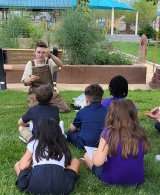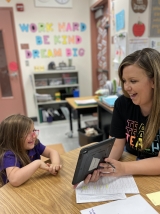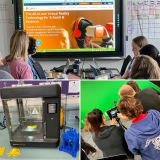-
Category 3
Selected in 2023
-
Grades: pre k - 5
School Setting: urban
Town Population: 336,534
Student Enrollment: 736
Student Demographics:
Black/African American: 13%
Teacher/Student Ratio: 1:25
White/Caucasian: 37%
Hispanic: 32%
Hawaiian/Pacific Islander: 1%
Asian: 7%
Native American: 1%
Other: 9%
% Reduced Lunch: 100%
% ELL Learners: 4.5%
Founded: 1953 -
PRINCIPAL:
Jennifer Furman-Born -
CONTACT:
330 Tin Street
Henderson, NV 89015
702-799-8930
furmajm@nv.ccsd.net
Gordon McCaw STEAM Academy Elementary School
Henderson, NV
McCaw created a challenging data-driven learning environment with high expectations to ensure success for every individual student.
- 1. Tell us about your school’s success.
- It is through high expectations that McCaw ES ensures success through an integrated curriculum, thriving community, culture, and climate. Goal-setting creates ownership in learning through an intellectually rigorous curriculum. An inclusive environment embeds activities and diversity for students to have equal opportunities to be valued, respected, and confident learners. We engage in the critical areas of Science, Technology, Engineering, Arts, and Math utilizing a rigorous STEM-infused curriculum and dynamic learning environments. Collaboration with all stakeholders ensures academic excellence for our students to thrive in a competitive world. We are a Nevada Governor’s Designated Model STEM School, Magnet Schools of America Certified National Demonstration School, and a Nevada School Performance Framework 5-Star school for the seventh consecutive year. McCaw continues to exceed state-determined accountability criteria specializing in serving our special populations of students.
- 2. Talk about the greatest contributing factor(s) that promoted positive change in your school.
- The greatest contributing factor to start our journey was the implementation of a clear vision. Following a specific school model we supported both academics and culture that was implemented school-wide to all stakeholders. Teachers now use data and the model to keep the focus sharp to guide and plan instruction and learn through meaningful professional development. Standards based grade-level instruction is presented in short, systematic, direct, and purposefully engaging ways. Students take ownership of learning through goal setting. Teachers are the facilitators of learning supporting students’ ability to attain goals and grow both academically and socially. Students articulate success criteria as well as seek support to master objectives. Once students reach a goal the celebration begins to keep students engaged and motivated. The celebrations bring positive energy and school-wide pride for all stakeholders no matter what level of accomplishment.
- 3. How has ESEA funding supported the school's success?
- Funding supports the school-wide model to impact all students’ pre-kindergarten through fifth grade. Our funds are spent to purchase national norm-referenced software programs in the content areas of reading and math to provide data, intervention, and acceleration. Professional development is provided utilizing the program data, creative focused intervention plans, guided student achievement and growth, enhanced differentiation, inclusionary best practices, etc. The remaining funding is used to support after-school tutoring and enrichment opportunities. Our tutoring is focused on specific student needs and delivered through engaging hands-on project-based learning activities and creative clubs such as steel drums, drones, robotics, and gardening/hydroponics.
- 4. What professional development activities were used to improve teaching and learning?
- Professional development (PD) is the foundation of McCaw. Spiraling and continuous PD ensures teachers remain up-to-date on new research regarding how children learn, emerging technology tools for the classroom, new curriculum resources, systems thinking, and more. PD is focused, collaborative, data-driven, and derived from working with students. Specific examples of PD: data analysis team collaboration, goal setting, long-range team instructional planning, summative assessment alignment, spatial-temporal math, number talks, project-based learning, Design Thinking Process, science strategies, and blended learning. This time provides concentrated reflection upon instructional practices and desired student benchmarks, as well as monitoring of outcomes to ensure success. Teachers collaborate on sharing successful lessons and strategies, best practices, differentiating instruction, common assessments, and intervention.
- 5. Talk about the cultural shift leading up to your school's success.
- McCaw created a challenging data-driven learning environment with high expectations to ensure success for every individual student. The shift was built upon changing stakeholder perspectives and expectations, and the use of data and daily goals to drive instruction, positive behavior intervention, and strong restorative practice. Teachers effectively use program and assessment data to craft mini-lessons and conferences with students setting specific, measurable, achievable, relevant, and timely goals in all academic areas. McCaw facilitates student ownership of their goals through teacher guidance, discourse, and building metacognition of student learning. Students can articulate their data and purpose for learning, goals, and current academic levels, as well as seek support to master the standards. Once students reach an individualized goal, special celebrations nurture the development of self-confidence, pride, and love of learning!
- 6. How has community involvement strengthened your success?
- Family and community engagement is a vital part of our success along with a school climate-structure that supports family involvement. Our school ensures we sustain strong ties to the community by creating partnerships with industries and local businesses. Additionally, we collaborate with the Governor’s office to seek solutions to engage students to help solve Nevada’s challenges such as drought and water conservation and state park conservation. Other learning experiences are tied to the community and focused on our STEAM theme. The community is involved in our school plan of operation, instructional model, and data. Our stakeholders are valued and provide input and support for science programs, exploration labs, and family engagement through school-wide STEAM events. Community involvement is expansive and an essential key aligned to our instructional school program model.
Stats
-
Category 3
Selected in 2023
-
Grades: pre k - 5
School Setting: urban
Town Population: 336,534
Student Enrollment: 736
Student Demographics:
Black/African American: 13%
Teacher/Student Ratio: 1:25
White/Caucasian: 37%
Hispanic: 32%
Hawaiian/Pacific Islander: 1%
Asian: 7%
Native American: 1%
Other: 9%
% Reduced Lunch: 100%
% ELL Learners: 4.5%
Founded: 1953 -
PRINCIPAL:
Jennifer Furman-Born -
CONTACT:
330 Tin Street
Henderson, NV 89015
702-799-8930
furmajm@nv.ccsd.net










